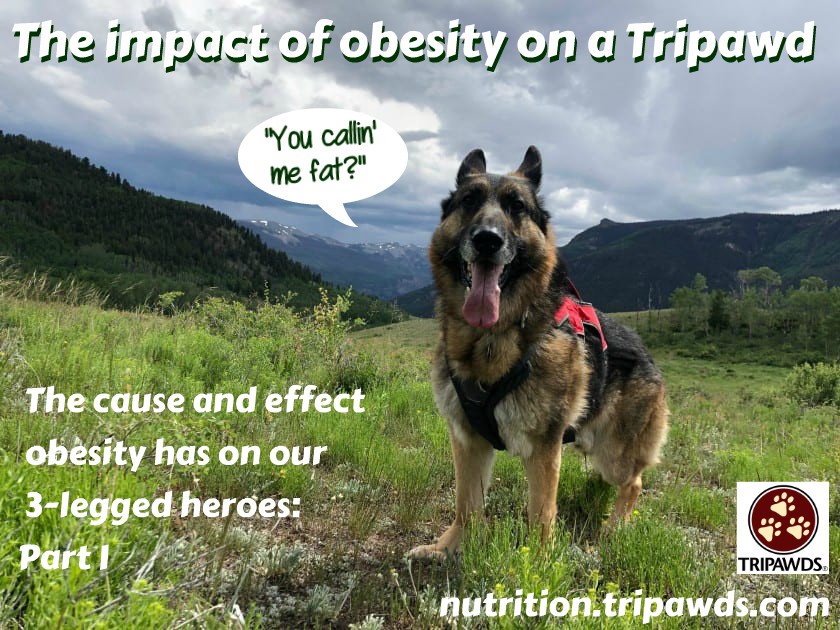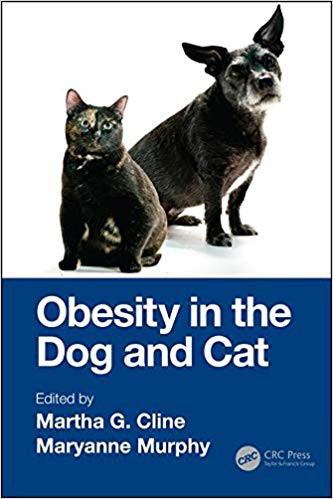Most vets are shy about telling clients that their Tripawd is overweight. Or their four-legged pets, for that matter. But as we learned at Tripawds Spokesdog Wyatt Ray’s last veterinary check-up, when they do speak up, it’s the first step toward a healthier life for our pets.

Weight management matters can make or break any pet’s quality of life, but especially Tripawds who have one less leg to lean on. Here’s why:
Life is Harder When a Tripawd is Overweight
There’s no denying our pets are fluffier than ever. In the newly released veterinary clinical handbook “Obesity in the Dog and Cat,” by Martha G. Cline and Maryanne Murphy, we learn that:
- 55.8% of dogs and 59.5 percent of cats are overweight
- Commercial pet food isn’t to blame, according to a few different studies.
- 97% of obese pets are overweight because of “human-specific factors, such as dietary factors, physical activity, owner attitudes and household characteristics.”
In other words, our pets are fat and it’s mostly our fault.

When a Tripawd is overweight (or any of our pets), it’s usually because we feed them too much and exercise them too little. That’s the simplest definition of pet obesity, of course.
Other factors can influence a pet’s weight, such as age or illness. But overall, when any pet puts on extra pounds, there is a failure on our part as loving pet parents to continuously monitor their food intake and exercise needs.
Vets are getting better at bringing up the weight conversation with clients, but many are still understandably reluctant to do so. They fear that the pet parent will take it personally and become upset.
At Wyatt’s last vet visit, I knew exactly how those pet parents feel. Here’s how our conversation with Wyatt’s orthopedic vet happened:
“Hmm, looks like Wyatt has put on some weight.”
“What? Wyatt? You think?”
“He does look heavier, and we like to see Tripawds look leaner,” she said, point blank. Then she asked the vet student to get a weight on him. When she did, the scale showed Wyatt was almost two pounds heavier than last time we visited.
My face turned beet red. I wasn’t mad at the vet, but at myself for not staying on track with his weight. We had been feeding him the same amount of food as always, without considering the impact of what had changed in his life. For example:
- Wyatt is older now, and gets much less activity than before.
- We hadn’t factored in the extra chow he eagerly gobbles down when we bribe him into his daily physical therapy exercises.
- And I can’t remember the last time we considered changing his meal portions whenever we rotate to a new food.
One or two pounds of weight doesn’t sound like a lot to us humans. But on a dog, even one pound has a big impact.
One Extra Pound, Lots of Problems
Every single pound of unnecessary weight on a dog is like five extra pounds on us humans. That extra fluff creates big problems in the body, including:
Chronic inflammation. Overweight pets and humans have bodies that live in a state of chronic inflammation. “This inflammatory state is thought to contribute to the development of cancer and other chronic diseases in humans,” write the authors of “Obesity in the Dog and Cat,” Martha G. Cline and Maryanne Murphy.
Increases the risk of CCL rupture by almost four times more than dogs of an ideal weight, according to one study. “This relationship between obesity and CCL rupture is due to the increased loading of the limbs and tension of the ligaments within the joints,” write Cline and Murphy.
Predisposes a pet to diabetes, cardiovascular problems, renal disease and even collapsed trachea. For pets and people alike, these conditions can make the simplest surgical procedure far more risky than it needs to be.
Just like in humans, these serious medical conditions in our pets are expensive to treat and diminish quality of life. The best way to avoid them is to get serious about helping your pet lose weight. In our next Nutrition blog post, we will explain how.
This post is dedicated to Grover, whose recent blog post started a great discussion about weight management for dogs. We hope you’ll hop over to check it out!
Thanks for the ref! We are so glad we found this site! 💜